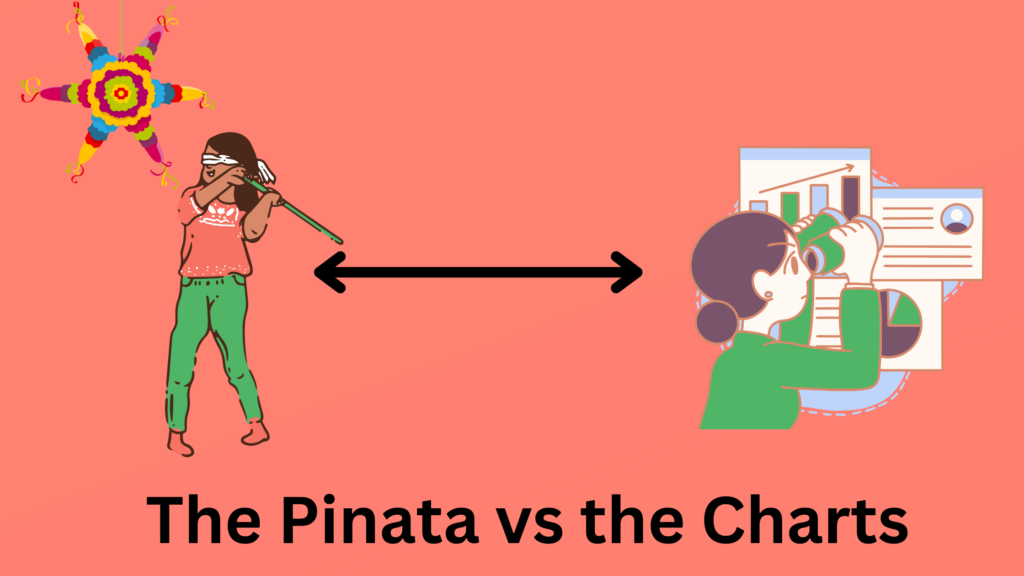
How do you make decisions to grow your business and put them into action? We all know we need to be strategic as we work to turn our vision into business growth. And we also know that we should “Just Do It” and make progress even when we are uncertain. So how do we balance the tension between planning and acting?
The way I see it – we all operate on a spectrum that has two extreme ends. Which one do you lean toward?
The Piñata Whacker
On one end, we have what I call “the piñata whacker.” This is the business owner who operates almost entirely on instinct and immediacy. Like someone blindfolded at a party, swinging wildly with a stick, they take action with minimal planning or strategy.
Piñata whackers might:
- Launch new products without market research (ACK!)
- Make major purchases based solely on gut feeling
- Pivot business models frequently without evaluating results
- Make impulsive hiring decisions
- Post random posts on social media with no marketing strategy to be sure they show up
The advantage of this approach is speed and momentum. Sometimes, piñata whackers get lucky and hit their target, resulting in unexpected success. The energy and enthusiasm they bring can be infectious, driving the business forward through sheer force of will.
However, resources get wasted with random swings. Money, time, and morale can all suffer when actions aren’t guided by some level of planning. Initially it might seem like you are busy DOING things, but in reality, the actions don’t actually lead to any progress. Or randomly they lead to progress, which can be even more confusing.
The Chronic Planner
At the opposite end sits “the chronic planner.” This business owner is caught in analysis paralysis, constantly researching, analyzing data, creating elaborate forecasts, and building complex decision matrices. Chronic Planners want to see charts, historic data, research. They take training courses and interview experts. This is often called “Paralysis by Analysis”.
Chronic planners might:
- Spend months gathering market data before launching a simple product
- Create detailed five-year projections down to the penny
- Require unanimous consensus before making any significant decision
- Get lost in industry reports and competitive analysis
The benefit of this approach is risk mitigation and thoroughness. Chronic planners rarely make catastrophic mistakes because they’ve considered every angle.
However, opportunities slip through their fingers while they’re perfecting their charts. In business, timing matters, and the market doesn’t wait for those who can’t decide. Chronic planners are so cautious that they are slow to act in a time when first to market (even if not perfect) tends to win.
Finding the Middle Ground
In an ideal world, you are able to understand where you fall on the spectrum of pinata whacker to paralyzed analyzer and moderate your tendencies to your benefit. Here’s how to find that middle ground:
If you’re a piñata whacker:
- Build simple planning habits into your routine
- Set aside dedicated time for reflection before major decisions
- Create basic metrics to track results
- Partner with or hire detail-oriented team members
If you’re a chronic planner:
- Set time limits on your research phases
- Start with small experiments rather than perfect solutions
- Remember that most business decisions are reversible
- Recognize that some information simply isn’t available beforehand
Small Business Application
For small business owners, finding this balance is particularly crucial because resources are limited. You can’t afford to waste money on random swings, nor can you afford to miss opportunities while perfecting your analysis.
Consider implementing a “plan, act, learn” cycle:
- Plan enough to establish clear direction and measurable outcomes
- Take decisive action based on your planning
- Learn from results and adjust accordingly
Look for tools that can help you start with strategy (for you whackers) and then take action (for you planners). Consider goal setting and task management resources like The 12 Week Year or Getting Things Done.
Additionally – consider sharing your goals with your fellow business owner peers in an accountability group or business owner roundtable group. This is helpful if you are a pinata whacker, because the group will ask questions and you will have to justify your actions to others. And this is also helpful if you are a chronic planner, because the group will hold you accountable to taking action.
Remember that the goal isn’t perfection—it’s progress (in the right direction!). The most successful small business owners aren’t those who never make mistakes; they’re those who learn quickly from them.
By knowing your natural tendencies and working to find balance, you can combine the best of both worlds: the thoughtful strategy of analysis with the decisive action of the piñata whacker.
So – which one are you? How do you find balance in this spectrum?


